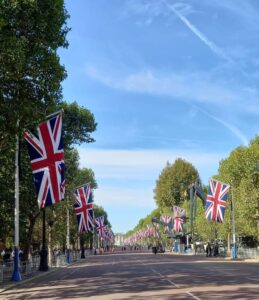After 70 years of reign, the death of Queen Elizabeth II on 8th September 2022 has generated considerable public interest and has reignited debates on the value of the monarchy. This article reflects on the impact of the royal family on UK tourism, nationally and regionally and the potential socio-economic legacy of Queen Elizabeth II.
In our combined work on Royal Tourism we have noted direct, explicit and indirect, implicit relationships between royalty and tourism in contemporary and historic UK and international contexts. Whilst we have acknowledged symbolic and cultural functions of monarchies, we have observed difficulties in fully grasping the extent of the UK monarchy’s economic influence due to the multifarious nature of their influence on society. Additionally, we have highlighted how problematic it is to rigorously measure the economic impact of tourism. Recent attempts to measure the size of the impact of the royal family on UK tourism have estimated the capital value of UK monarchy as a business to be £67.5 billion (up from £44 billion in 2012) and the annual contribution to the UK economy to be £1.766 billion. These estimates included indirect economic effects on tourism, trade, media and arts.

Since 2017, there has been no published in-depth analysis of the economic impact and brand value of the UK monarchy. However, given public interest events since 2017 (including royal weddings and the Queen’s Platinum Jubilee in 2022), even accounting for the impact of the COVID-19 pandemic on tourism figures from 2020 to early 2022, we might expect an upwards trajectory on the economic uplift linked to tourism that was reported in 2017, representing an impact more than £550 million.
Visit Britain, the national tourism agency, responsible for marketing England, Scotland and Wales worldwide, does not collate statistics on the royal family as an attraction. However, previous research findings indicate that 60% of overseas visitors to Britain are likely to visit places associated with the royal family and more than a third of tourists visiting London list Buckingham Palace as a ‘must see’ top preference. Furthermore, the Tower of London, housing the Crown Jewels, is reputedly amongst the most visited paid-for UK attractions.
Whilst the economic impact from royal tourism, domestic and inbound, is linked to attractions and events connected to the royal family past and present, little attention has been paid to the regional employment of monarchy as a place representation tool.
Regional tourism opportunities by royal association
Although the majority of UK visitor attractions have no associated links with the royal family and there is arguably a privileging of England and London in royal associative place making, the distribution of royal properties and the (recently redistributed) regional titles for working royals extend more widely across the UK. The island of Anglesey in north-west Wales, former home to the now Prince and Princess of Wales, reportedly enjoyed a 20% increase in tourism business during their residency and King Charles III’s property, Llwynywermod, in Carmarthenshire, West Wales showcases Welsh materials and furnishings from local craftspeople. Most recently, exploitation of the popularity of London since the death of Queen Elizabeth II has been witnessed through doubling of hotel room prices.
We have noted a typically deferential emphasis on royal associations with particular places in the promotion efforts of public sector tourism agencies. A need to retain the mystique of royalty may explain the absence of images of living royals in tourism promotional literature but this appears to extend to the private sector. For example, Yew Tree Farm in Borrowdale in north-west England has previously hosted visits from the now King Charles III but refrained from claiming his royal patronage in their publicity materials and it is difficult to discern any associated visitor impacts with the region. In contrast, we have seen no hesitancy in English Heritage’s promotion of the Isle of Wight as an opportunity to ‘Holiday like Queen Victoria’. Similarly, royal heritage themes are used in some Welsh places to attract niche markets. With the support of King Charles III a move towards making royal residences more accessible to the public is noted, with recent reports that Balmoral in Scotland is set to reopen with free admission to the grounds to provide visitors with a space to reflect on the life of the late Queen Elizabeth II.
Change and legacy
Royal Tourism is not solely for economic gain and commercial exploitation (one of the most enduring and publicly contested aspects of relationships between tourism and monarchy) but also has a political and socio-cultural context. Thus, responses to monarchy and the UK royal family in tourism are embedded in the institutional fabric of society and popular culture. We note, how the impact of the loss of Queen Elizabeth II has been expressed in terms of symbolic influence, social positioning, and cultural functions linked to her presence (and now her absence). We have observed the power of a monarch in attracting the tourist gaze of domestic and international visitors, albeit difficult to quantify in hard metrics. We have also witnessed, amongst habitual, dedicated, and enthusiastic ‘Royal Tourists’, a psychological need for royal narratives and for imagined participation in royal lives that has persevered. Yet, we note tensions within the devolved nations of Scotland and Wales around the transition of monarch.
Earlier speculations around what would happen if the Queen’s reign ended focused on immediate economic impacts linked to designating the state funeral and subsequent coronation as UK public holidays; forecasting a loss of UK GDP between £1.2 billion and £6 billion. Perhaps understandably, much less has been said about potential longer-term impacts. The significance of the loss of Queen Elizabeth II is highly visible in terms of the depth and breadth of emotional responses to her passing. At this point in time, it is difficult to say more about the legacy for UK society, national and regional identities and, in turn, UK tourism.

Nicola Palmer (Twitter) is currently based in the Doctoral School and the Culture & Creativity Research Institute at Sheffield Hallam University and is also an academic at the University of York. Her research focuses on tourism governance, notably the role that social status, legitimacy and power play in the dynamics of sustainable community-based tourism development.

Claire Haven-Tang (Twitter) is the Associate Dean (Research) in the Tourism, Hospitality and Events Management department at Cardiff Metropolitan University. Claire was a member of the Visit Wales Digital Tourism Business Project Steering Group and has previously worked in the National Audit Office, on projects involving the Department of Culture, Media and Sport.
Are you currently involved with regional research, policy, and development? The Regional Studies Association is accepting articles for their online blog. For more information, contact the Blog Editor at rsablog@regionalstudies.org.